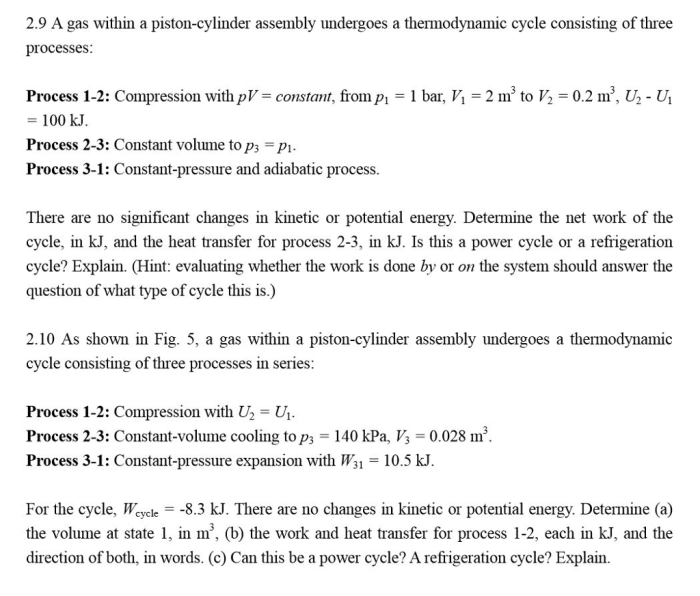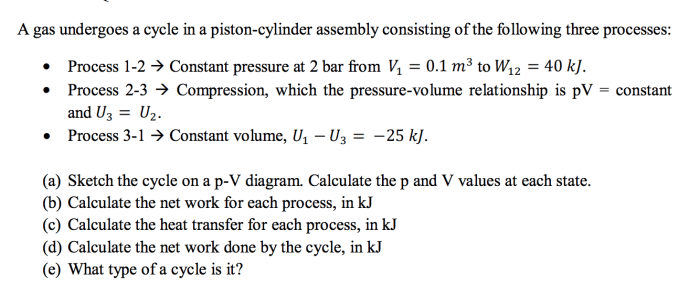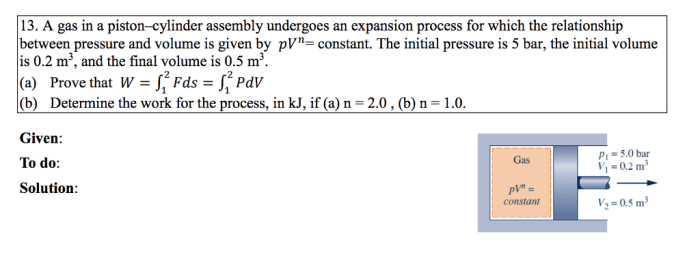A gas undergoes a process in a piston-cylinder assembly – In the realm of thermodynamics, the study of a gas undergoing a process within a piston-cylinder assembly unveils fundamental principles governing the behavior of gases and their interactions with their surroundings. This exploration delves into the intricate relationship between heat, work, and internal energy, providing a deeper understanding of the macroscopic properties of gases.
The piston-cylinder assembly serves as a versatile apparatus, allowing for the controlled manipulation of gas volume and pressure. By analyzing the changes in these parameters, scientists can gain insights into the thermodynamic processes that shape the behavior of gases, paving the way for advancements in engineering and scientific disciplines.
Piston-Cylinder Assembly
A piston-cylinder assembly is a mechanical device that consists of a cylinder and a piston that moves within the cylinder. The piston is connected to a piston rod, which in turn is connected to a crankshaft. The crankshaft converts the reciprocating motion of the piston into rotary motion.
Piston-cylinder assemblies are used in a wide variety of applications, including engines, compressors, and pumps.
Types of Piston-Cylinder Assemblies
- Single-acting piston-cylinder assemblies have a piston that moves in only one direction.
- Double-acting piston-cylinder assemblies have a piston that moves in both directions.
- Opposed-piston piston-cylinder assemblies have two pistons that move in opposite directions.
Thermodynamics of a Gas Undergoing a Process in a Piston-Cylinder Assembly
The first law of thermodynamics states that the change in internal energy of a system is equal to the heat added to the system minus the work done by the system. In the case of a gas undergoing a process in a piston-cylinder assembly, the heat added to the system is equal to the change in internal energy plus the work done by the gas on the piston.
Gas Processes: A Gas Undergoes A Process In A Piston-cylinder Assembly

Types of Gas Processes, A gas undergoes a process in a piston-cylinder assembly
- Isothermal processes are processes in which the temperature of the gas remains constant.
- Adiabatic processes are processes in which no heat is transferred to or from the gas.
- Isobaric processes are processes in which the pressure of the gas remains constant.
- Isochoric processes are processes in which the volume of the gas remains constant.
First Law of Thermodynamics
The first law of thermodynamics can be applied to gas processes in a piston-cylinder assembly to determine the change in internal energy, heat added, and work done.
Heat, Work, and Internal Energy
Heat is the transfer of thermal energy from one object to another. Work is the transfer of energy from one object to another by means of a force. Internal energy is the energy of the particles that make up a system.
Ideal Gas Law

Ideal Gas Law and Assumptions
The ideal gas law is a mathematical equation that describes the relationship between the pressure, volume, temperature, and number of moles of a gas. The ideal gas law assumes that the gas particles are point masses that do not interact with each other.
Using the Ideal Gas Law
The ideal gas law can be used to analyze gas processes in a piston-cylinder assembly. By knowing the initial and final conditions of the gas, the ideal gas law can be used to determine the change in pressure, volume, temperature, or number of moles.
Examples of Ideal Gas Law Applications
- The ideal gas law can be used to determine the pressure of a gas in a cylinder.
- The ideal gas law can be used to determine the volume of a gas in a cylinder.
- The ideal gas law can be used to determine the temperature of a gas in a cylinder.
- The ideal gas law can be used to determine the number of moles of a gas in a cylinder.
Non-Ideal Gas Behavior

Limitations of the Ideal Gas Law
The ideal gas law is a good approximation for the behavior of many gases at low pressures and high temperatures. However, at high pressures and low temperatures, the ideal gas law becomes less accurate.
Concept of Non-Ideal Gas Behavior
Non-ideal gas behavior is the deviation from the ideal gas law. Non-ideal gas behavior can be caused by a number of factors, including intermolecular forces and the finite size of gas particles.
Examples of Non-Ideal Gas Behavior
- The pressure of a non-ideal gas is less than the pressure predicted by the ideal gas law.
- The volume of a non-ideal gas is greater than the volume predicted by the ideal gas law.
- The temperature of a non-ideal gas is less than the temperature predicted by the ideal gas law.
Applications

Applications of Piston-Cylinder Assemblies
- Piston-cylinder assemblies are used in engines to convert the reciprocating motion of the piston into rotary motion.
- Piston-cylinder assemblies are used in compressors to compress gases.
- Piston-cylinder assemblies are used in pumps to pump fluids.
Advantages of Piston-Cylinder Assemblies
- Piston-cylinder assemblies are simple to design and manufacture.
- Piston-cylinder assemblies are relatively inexpensive.
- Piston-cylinder assemblies are efficient.
Disadvantages of Piston-Cylinder Assemblies
- Piston-cylinder assemblies can be noisy.
- Piston-cylinder assemblies can be bulky.
- Piston-cylinder assemblies can be heavy.
Top FAQs
What is the purpose of a piston-cylinder assembly?
A piston-cylinder assembly is a device that allows for the controlled manipulation of gas volume and pressure. It is used to study the thermodynamic processes that shape the behavior of gases.
What are the different types of gas processes that can occur in a piston-cylinder assembly?
The different types of gas processes that can occur in a piston-cylinder assembly include isothermal, adiabatic, isobaric, and isochoric processes.
How is the ideal gas law used to analyze gas processes in a piston-cylinder assembly?
The ideal gas law is used to analyze gas processes in a piston-cylinder assembly by relating the pressure, volume, and temperature of the gas to each other.
What are the limitations of the ideal gas law?
The ideal gas law assumes that gas particles are point masses with no intermolecular forces. This assumption is not always valid, especially at high pressures and low temperatures.